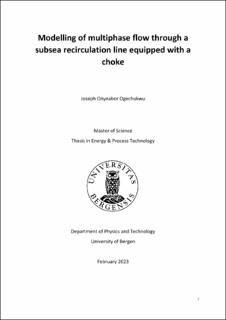Modelling of multiphase flow through a subsea recirculation line equipped with a choke
Master thesis
Permanent lenke
https://hdl.handle.net/11250/3061274Utgivelsesdato
2023-02-23Metadata
Vis full innførselSamlinger
- Master theses [170]
Sammendrag
A peculiar problem encountered in engineering practices for multiphase flows is the pressure loss in piping systems. Because of the variations in viscosities, densities, and velocities of the fluid phases, multiphase systems design requirements are different from those of singlephase flows. Irrespective of the number of phases involved, pressure loss occurs at different points of the pipe. The severity is however more in multiphase flows due to the variations in the fluid compositions across the length of the pipe. Works of literature on the pressure drop across chokes or valves for multiphase fluids are very limited due to the complexities and flow regimes bothered around the valve system. Moreso, most researchers only bother with the frictional losses along the pipeline as these are considered to constitute most of the losses. Current practices are only just interested in designing and sizing valves based solely on the pressure drop across a valve for single-phase flows. In this work, Daniel Bernoulli’s model or equation was evaluated against empirical data from OneSubsea company in a bid to predict the pressure drop across a choke in a subsea recirculation line for multiphase flow. The equation was used to quantify and evaluate the performance characteristics of a valve handling multiphase gas-water-oil flow, as this kind of flow is commonly seen in processing industries. The received measured data include a 6-in-diameter pipe, with 60 meters equivalent length, and twenty-six bends. Stem travel from 7.1% to 70.5% for a recirculation pipe was evaluated against 118 data values of Gas Volume Factor GVF and Water Liquid Ratio WLR to obtain the control valve coefficients at different flow rates under varying temperatures and pressure. The results showed a good correlation in line with the principle of energy conservation or continuity equation when the flow rate ‘Q’ was measured against the pressure drop across the valve. Other quantitative relationships evaluating the effects of GVF, Bulk density of the fluids mixture against the pressure drop across the valve were also determined. The detailed evaluation carried out allows for local flow characteristics of pressure drop, flow rates, and GVF determination within the valve. The parameters can be incorporated in the sizing methodology of control valve systems for multiphase oil-water-gas flow.
